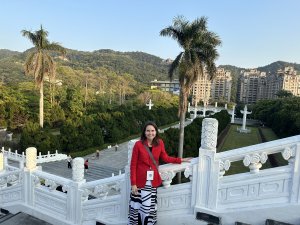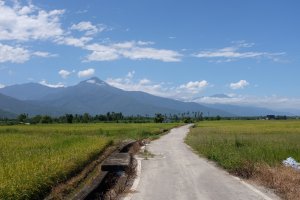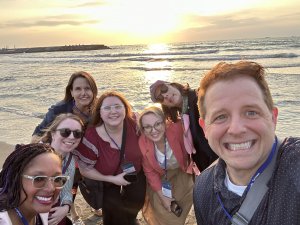I was delighted and honored to learn that I had been named a Fulbright Senior Scholar while on sabbatical leave from SUNY-‐Buffalo -‐ not merely on account of the award’s prestige or the actual monetary support it entails, but most importantly because it represented a golden opportunity to deepen my knowledge in the field of pre-‐mRNA splicing by learning from an international expert in the land of my birth, which I had left thirty years ago. This paper contains reflections on my stay in Taiwan as a Fulbright Senior Scholar over the past 6 months.
Cultural Experiences: It has been over 30 years since I left Taiwan for the United States and in the intervening time, I have managed a handful of short visits. While I am as familiar with the language as anyone who lives here – meaning I can read the local newspapers, watch the local television, and on the whole lead my daily life without difficulty here in Taiwan – there is still a bit of disconnect in term of idiomatic word usage and appropriate situational responses.
On reflection, I would rank the lack of personal space and/or distance as the most important adjustment I had to make. An example is the following situation (one of many similar ones): when we brought our triplet toddlers with us and were walking with them on the street or taking the MRT, we often encountered curious onlookers who proceeded to inquire how the babies were conceived, etc. The type of questions we had to field would normally have been considered “off-‐limits” or even rude back in the United States, simply because these questions are rather personal in nature. It took some time for both me and my wife (who is also Taiwanese and lived in Taiwan even longer than I did before leaving for the USA) to get used to, despite having grown up here in Taiwan.
On the other hand, we had many positive experiences during our stay here in Taiwan: the people and their kindness were something that we will always remember. There were always individuals who would relinquish a seat on the MRT for our family, no matter how crowded or busy it was. Time and again, taxi drivers patiently waited for our toddlers to get in and out of their vehicles, and stayed calm despite our toddlers’ frequent tantrums. There were always friendly pedestrians lending a hand when our strollers got stranded getting on or off stairs. Ultimately, it was the people here who represent the most enjoyable aspect of life here, and that’s what gives Taiwan a special place in our hearts.
With respect to peoples’ lives, one thing that I felt deeply is how expensive things have become and this left me wondering how people survive with their current salary level, when prices of everything around them keep on increasing while pay does not. This problem is probably most obvious here in Taipei.
With respect to transportation, the MRT in Taipei is by far the best public transportation I have ever experienced. This is my opinion after having experienced public transportation in cities like Berlin, Washington DC, New York City, Chicago, London, Paris, and Prague. The Taipei MRT is clean, efficient, and affordable. Our kids thoroughly enjoyed their experiences riding the MRT – to the point where we had to take trips sometimes just so they could ride the MRT for a few stops to make them happy. On that note, the Taiwan High Speed Rail is also something that also impressed me deeply and is a joy to ride. It makes me wish that the US might one day adopt such high speed rail system!
In terms of local cuisine, Taiwan is famous for its myriad of eateries. However, incidents of tainted lard and ingredients were reported during my stay here in Taiwan – a fact which has greatly shattered my confidence in venturing out to the nightmarkets to try out different local cuisines.
One of the great benefits I felt was the experience our triplet toddlers had by attending a local Montessori-‐style preschool. Their Mandarin skills improved tremendously and they were able to compare and contrast the different schooling systems between East and West.
Research Experiences: I had a great opportunity to carry out my proposed Fulbright Research in one of the top institutes in the world – the Institute of Molecular Biology (IMB) at Academia Sinica. My host primary investigator (PI) is Dr. Soo-‐Chen Cheng, a world-‐ renowned expert in the field of pre-‐mRNA splicing and a distinguished researcher who pioneered the methodology of generating yeast splicing extracts to allow in vitro studies to be carried out on the molecular mechanisms underlying the cellular machinery that perform the process of pre-‐mRNA splicing.
The institute and the laboratory itself feature a wealth of resources, from reagents to instruments to the knowledge base of individual lab members. Dr. Cheng has been extremely gracious, fostering a stimulating scientific learning environment in her laboratory. During my stay in Dr. Cheng’s laboratory, I was able to successfully engineer the yeast strains with which I will be carrying out further studies to determine the role of protein arginine methyltransferase Hmt1 in facilitating different functional aspects of a pre-‐mRNA splicing factor Prp19. Due to time constraints, I was not able to fully complete my proposed studies of Hmt1’s role on Prp19, as I spent a bulk of my time generating the yeast strains necessary to complete these studies. Nevertheless, these strains will allow the next phase of the experiment to take place in the immediate future, as I plan to finish the work upon my return to the United States.
But perhaps the greatest accomplishment and most rewarding experience on the research front was learning how to make an active yeast splicing competent extract. Dr. Cheng is one of the pioneers of this approach and one of the first authors who to publish this study. It is a delicate procedure that requires precision and patience. Based on her experiences, Dr. Cheng reminded me a number of times that not everyone is capable to making a competent extract even when given a chance.
The entire procedure took a long time – approximately 10 hours from the start to finish in terms of making the extract itself. It took two days of preparation in advance to generate the materials required for making the extract, and another day or two to test the activities of the prepared extract. At the end, I was able to generate competent extracts showing a good level of activity. These extracts will be shipped back to my laboratory in the USA for further use in our research.
Now that I have experience in carrying this procedure out successfully, it will be an important methodology to help us pursue our next phase of research with respect to how protein methylation modulates the process of pre-‐ mRNA splicing, a point that I had highlighted in my recent National Science Foundation investigator-‐initiated project application. In addition, Dr. Cheng has offered many of her reagents for use in our projects, such as DNA constructs, custom splicing factor antibodies, as well as technical assistance/consultation in the future. Without the support of the Fulbright Senior Scholar award, none of this would have been possible.
During my stay here at IMB, I was able to participate in two conferences, and at one I gave an oral presentation. I had also gave a seminar in the IMB (on the topic of Hmt1 and the control of RNA polymerase III transcription) and gave another seminar (on the topic of protein arginine methylation and the control of pre-‐mRNA splicing) in a special RNA club meeting on Nov. 26 at the IMB.
In addition, I have been an active participant of Dr. Cheng’s weekly group meetings, from which I learned about the research progress of individual members of Dr. Cheng’s laboratory and benefited immensely from those lively discussions. IMB and its surrounding institutes have hosted a variety of seminars featuring speakers from top universities/institutes from all over the world and I have been very fortunate to attend many of those seminars. It was a great learning experience that greatly enhanced my professional development as faculty in the field of Biological Sciences.
Finally, I have established a collaborative relationship with another investigator at the IMB, Dr. Hung-‐Ta Chen, who works on structural studies of RNA polymerase III transcription. One of the new discoveries my lab made in the past few years is a role for protein arginine methyltransferase Hmt1 in the control of RNA polymerase III transcription and our progress has now attained at a juncture where we would need to work with outside collaborators who possess these types of expertise in order to answer some of the outstanding questions in that research topic.
Dr. Chen’s work and expertise fit the ideal profile of a collaborator, and we are delighted that they will help us resolve these issues with respect to that project. Together with his post-‐doctoral fellow, Dr. Chen will help carrying out a number of in vitro studies to further delineate the role of a specific RNA polymerase III subunit in the context of protein arginine methylation. In addition, he has offered to provide us with precious sample preparations of other RNA polymerase III components with which we will be able to test their potential on becoming a substrate of Hmt1. I believe that we will initiate a fruitful collaboration that would ultimately result in a peer-‐reviewed professional publication joint-authored by members of both labs.





